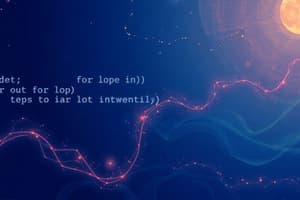Podcast
Questions and Answers
What is the primary purpose of using loops in programming?
What is the primary purpose of using loops in programming?
- To perform repetitive tasks efficiently without duplicating code (correct)
- To execute code redundantly without saving time
- To create infinite sequences of numbers
- To complicate the code structure for better readability
What type of loop is used in Python to execute a block of code a fixed number of times?
What type of loop is used in Python to execute a block of code a fixed number of times?
- Nested loop
- While loop
- Do-while loop
- For loop (correct)
Which of the following describes what an iterable is in Python?
Which of the following describes what an iterable is in Python?
- An object that can only be a string
- Any file type that cannot be opened
- An object that can be iterated over, like lists and tuples (correct)
- Any number that can be calculated
Which statement is true regarding the while loop in Python?
Which statement is true regarding the while loop in Python?
Which of the following statements is true about the 'break' statement in loops?
Which of the following statements is true about the 'break' statement in loops?
What does it mean to have a nested loop in Python?
What does it mean to have a nested loop in Python?
How does the continue statement function in a loop?
How does the continue statement function in a loop?
In Python, what does a for-else loop do?
In Python, what does a for-else loop do?
What is the primary purpose of a while loop in programming?
What is the primary purpose of a while loop in programming?
What will happen if the condition of a while loop is initially false?
What will happen if the condition of a while loop is initially false?
Which of the following is true about the indentation in a while loop?
Which of the following is true about the indentation in a while loop?
What does the 'step' parameter in the range() function specify?
What does the 'step' parameter in the range() function specify?
When using range(3, 8), which of the following numbers will be printed?
When using range(3, 8), which of the following numbers will be printed?
What is the primary purpose of the range() function in Python?
What is the primary purpose of the range() function in Python?
What is the purpose of the 'in' keyword in a for loop?
What is the purpose of the 'in' keyword in a for loop?
Which of the following can be considered an iterable object?
Which of the following can be considered an iterable object?
What does the continue statement do in a for loop?
What does the continue statement do in a for loop?
What happens when a break statement is executed within a loop?
What happens when a break statement is executed within a loop?
In a for-else construct, when is the else block executed?
In a for-else construct, when is the else block executed?
How can you skip printing specific items in a list using a for loop?
How can you skip printing specific items in a list using a for loop?
What does the example output when using 'for letter in 'Python': print(f"Current letter: {letter}")'?
What does the example output when using 'for letter in 'Python': print(f"Current letter: {letter}")'?
In the following code: for i in range(10): if i == 5: break, what will be the output?
In the following code: for i in range(10): if i == 5: break, what will be the output?
What is the function of the range() function in a for loop?
What is the function of the range() function in a for loop?
Which of the following statements about a for loop is true?
Which of the following statements about a for loop is true?
What will be the output of the following code: for i in range(1, 10): if i % 2 != 0: continue print(i)?
What will be the output of the following code: for i in range(1, 10): if i % 2 != 0: continue print(i)?
What is the output of this code snippet: fruits = ['apple', 'banana', 'mango', 'grape', 'orange']; for fruit in fruits: if fruit == 'mango': continue; print(fruit)?
What is the output of this code snippet: fruits = ['apple', 'banana', 'mango', 'grape', 'orange']; for fruit in fruits: if fruit == 'mango': continue; print(fruit)?
Flashcards
for loop
for loop
A programming construct that allows you to execute a block of code repeatedly for a fixed number of times.
while loop
while loop
A programming construct that allows you to execute a block of code repeatedly as long as a certain condition is true.
range() function
range() function
A function that generates a sequence of numbers within a specified range. You can use it to determine how many times a loop will iterate.
Iterables
Iterables
Signup and view all the flashcards
break statement
break statement
Signup and view all the flashcards
continue statement
continue statement
Signup and view all the flashcards
for-else loop
for-else loop
Signup and view all the flashcards
while-else loop
while-else loop
Signup and view all the flashcards
Start (range function)
Start (range function)
Signup and view all the flashcards
Stop (range function)
Stop (range function)
Signup and view all the flashcards
Step (range function)
Step (range function)
Signup and view all the flashcards
Variable (for loop)
Variable (for loop)
Signup and view all the flashcards
Iterable (for loop)
Iterable (for loop)
Signup and view all the flashcards
for (for loop)
for (for loop)
Signup and view all the flashcards
Pre-Tested Loop
Pre-Tested Loop
Signup and view all the flashcards
Loop Body
Loop Body
Signup and view all the flashcards
Indentation
Indentation
Signup and view all the flashcards
Loop
Loop
Signup and view all the flashcards
Decrementing
Decrementing
Signup and view all the flashcards
Incrementing
Incrementing
Signup and view all the flashcards
String
String
Signup and view all the flashcards
In (Keyword)
In (Keyword)
Signup and view all the flashcards
Loop Variable
Loop Variable
Signup and view all the flashcards
Iteration
Iteration
Signup and view all the flashcards
Loop Condition
Loop Condition
Signup and view all the flashcards
Looping
Looping
Signup and view all the flashcards
Data Storage
Data Storage
Signup and view all the flashcards
Sequence
Sequence
Signup and view all the flashcards
Dictionary
Dictionary
Signup and view all the flashcards
Study Notes
Python Programming - Day 4
- The session covers Python loops, specifically
forandwhileloops, along with associated concepts likerange()function, flow charts,break, andcontinuestatements. - Python loops are crucial for automating repetitive tasks, instead of manually repeating the same code multiple times.
forloops execute a block of code repeatedly for a set number of times.whileloops execute a block of code repeatedly as long as a condition remains true.
- The
range()function generates sequences of numbers, used extensively in loops.- Its syntax is
range(start, stop, step). start,stop, andstepare integer values.stoprepresents the integer up to which the sequence is generated (exclusive).- if start is not provided, it defaults to zero.
- if
stepis omitted, it defaults to 1
- Its syntax is
range()function is part of Python's iterable objects, along with lists ([]), tuples (()), strings (""), dictionaries ({}), and other iterable objects that can be used inforloops.inis a membership operator for sequence inclusion checkingbreak: Terminates the loop immediately when a condition is met, even in the case of awhileloop checking for a condition which is still truecontinue: Skips the remaining code in the current loop iteration, continuing to the subsequent iteration.for-elseblock checks if the loop runs to completion, executing it'selsestatement without encounteringbreakwhile-elseconstruct behaves similarly: execute theelseblock if nobreakis encountered.- Nested loops involve placing one loop inside another; enabling multi-dimensional operations.
Loop Flow Chart Diagrams
- Specific flow charts are provided for
forandwhileloops demonstrating loop conditions, execution paths, and termination points within these types of programming structures.
Python Loop Examples
- Multiple examples demonstrate the application of
forandwhileloops, including therange()function and membership operator. The examples illustrate iteration over different data types (strings, lists, etc.) and various loop conditions to show flexible ways to loop through and modify data in python. A clear understanding of the examples allows programming students to better comprehend the use of these loops.
Programming Assignments
- The provided assignment details practice scenarios involving loops such as number printing, finding tables, checking palindrome/Armstrong numbers, and calculating factorials using these looping techniques.
Studying That Suits You
Use AI to generate personalized quizzes and flashcards to suit your learning preferences.



